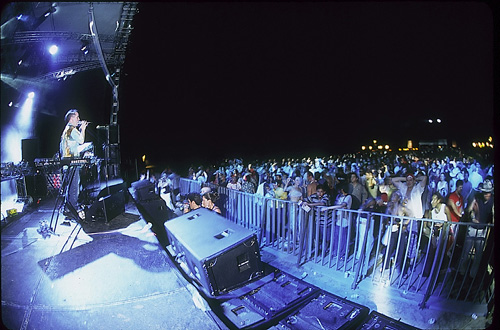UAD-1 Feature: Electric Skychurch Puts Faith In Mackie UAD-1
 |
|
Electric Skychurch and 40,000 friends at "Acafest 2002" Acapulco, Mexico
photo by Bobby Fresh |
“It’s not common to have a huge rack of LA2As in any one place in time, so I’d never had the experience of working with that many of them at once until we started working with the UAD-1”.
Lumb explains the album concept this way: “The Clock evolved from a piece of music I did when I was hired to play in New Orleans on New Year’s Eve in 1999 (becoming 2000). I was invited to do the countdown from 11 p.m. to 12 a.m. In keeping with the Y2K theme, I put together a big clockwork machine and wove music through it. It was an exercise in building tension and fear over an hour, and then a release. The Clock is also inspired by playing live. When you play live the clock that runs all the machines can make the music very mechanical, so creating a piece that makes the transition between mechanical electronic music and completely acoustic, played the good old fashioned way by hand, is a really interesting thematic device. What we’re basically doing with The Clock is going back and forth between making music with machines and making music with people.”
Crucial to their creative process is the Mackie UAD-1 with Powered Plug-Ins. Says Lumb; “We’re using the UAD-1 in the studio to get the perfect, the most present vocal sound and the most in your face drums you can possibly get”.
While Lumb uses a computer and electronic tools, he doesn’t consider his process computer-centric. “The computer is just another instrument in my studio. I record everything through the Neve and Apogee and I use a lot of 1176s. I tend to hire a particular set of vintage units – we joke that if it looks like it fell down the stairs, it’s probably the one we want. But I can tell you that Universal Audio does a really good job of emulating components of the machine in addition to the theory behind it, which is why these plug-ins sound so good. UA nailed it. And, when the UAD-1 came out, it worked – on the first generation.
“What’s great about the UAD-1 is that I now have a set of tools in hardware analog world and the software world that do the same thing and work the same way. But the great thing about the Powered Plug-Ins is how many you have on hand. It’s not common to have a huge rack of LA2As in any one place in time, so I’d never had the experience of working with that many of them at once until we started working with the UAD-1. It’s allowed us to play around with production techniques – because we can. My favorite thing to do with the UAD-1 card is to take drum submixes and route them through the Powered Plug-Ins LA-2A in stereo. And we love having lots of 1176s to process all the vocals after the fact – with a different one on each vocal. I also love Nigel – I use it to create distortion on our analog keyboards. I find that if I run a keyboard through Nigel it might sit in the digital tracks just a little bit better. It kind of takes it into the virtual digital realm.
 |
|
James Lumb and Roxanne Morganstern performing their “Electro Duet”
|
Working with a range of vocalists can be a challenge in the studio. Lumb finds that the UAD-1’s 1176 gives him the flexibility he needs. “When I want a really up close, standing right next to you kind of vocal sound, almost conversational, I use the 1176. It’s really intimate and ideal for somebody who doesn’t sing very loud. However, I also work with Roxanne Morganstern and Roxanne is famous for being the loudest chick in California. Absolutely. People joke that we don’t even need a microphone for this girl she’s so loud. The difference between her loudest peak and her softest is so dramatic that we have to be really conservative on the front end. So with the UAD-1, we’re able to get the most dynamic performance possible and then have the choice to squish the hell out of it with the 1176. It’s so transparent and it doesn’t sound distorted – it’s very clear.”
Asked about the creative pulse behind the project, Lumb had this to say, “I absolutely love the sound we’re getting. We’re trying to emulate the sound of our favorite music from the 60’s and 70’s and using different production techniques as a narrative device. In some places we have really warm acoustic soundscapes and in others we have really cold distant electronic soundscapes. We assemble those elements into sub-mixes, and then we take the submixes and re-assemble them into larger pieces. It’s a longer form of music than we’ve done before and within the framework of the music we’ve created little pop songs, little pop-outs. But we’ve still kept the DJ style that continues on and gradually becomes something else.”
www.skychurch.com